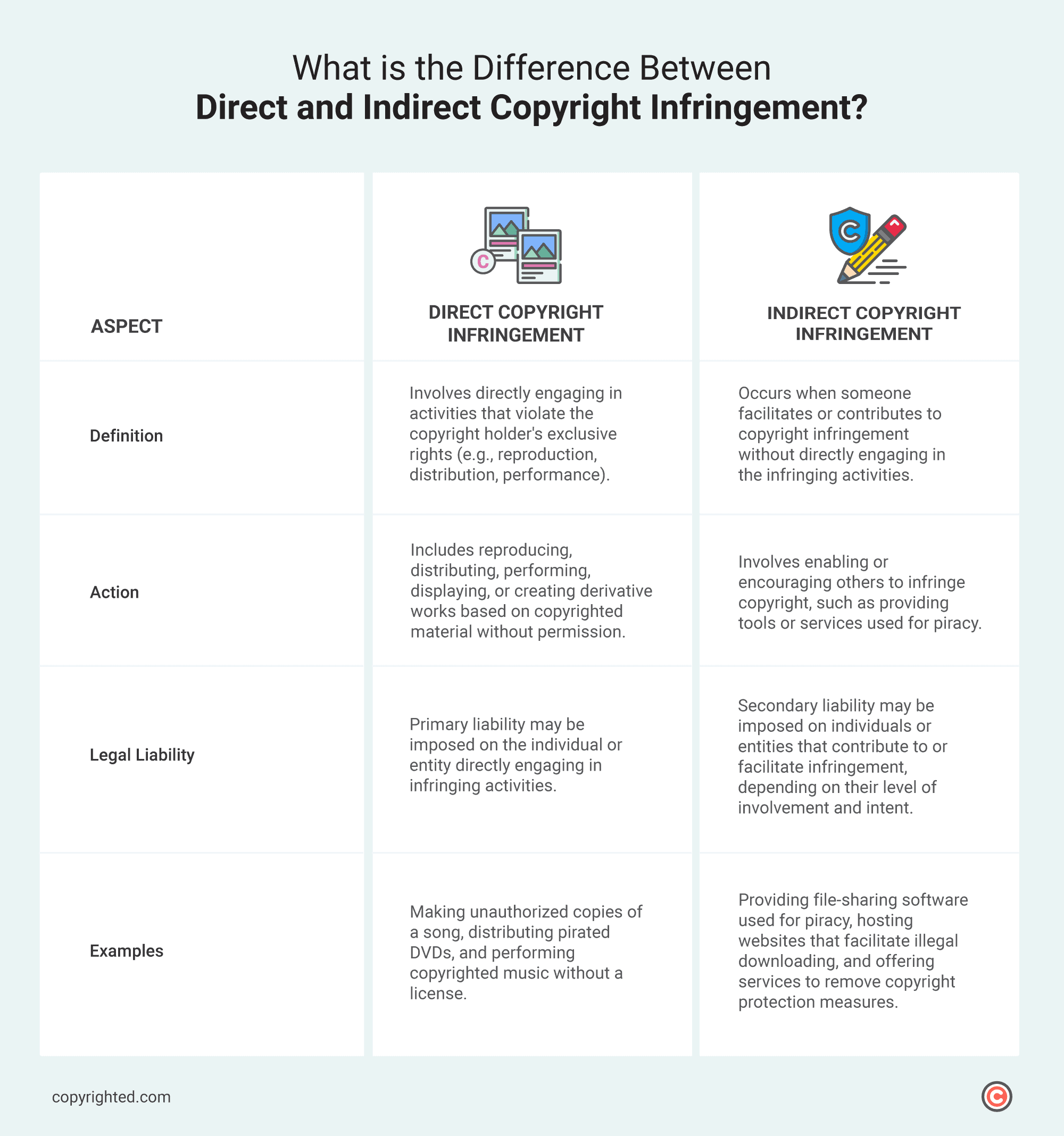Among the various challenges faced in protecting creative works is the issue of direct copyright infringement. Understanding what constitutes direct infringement and how it occurs is essential for creators, copyright holders, and consumers alike.
In this article, we delve into the concept of direct copyright infringement, exploring its definition, examples, and the mechanisms through which it occurs. By delving into this matter, we can identify more effective ways to protect the rights of creators and copyright holders.
- Direct copyright infringement can result in legal consequences, including financial damages and injunctions to cease the infringing activities.
- Indirect infringement occurs when someone facilitates or contributes to copyright infringement without directly engaging in the infringing activities.
- Primary liability may be imposed on the individual or entity directly engaging in infringing activities.
Table of Contents
What is Direct Copyright Infringement?
Direct copyright infringement refers to the unauthorized use of copyrighted material in ways that violate the exclusive rights granted to the copyright holder. These exclusive rights typically include the right to reproduce the work, distribute copies of it, publicly perform or display it, and create derivative works based on it.
An example of direct copyright infringement includes creating derivative works based on copyrighted material such as making a movie adaptation of a book without obtaining the necessary rights. Distributing copies of a copyrighted work without permission is also an instance of direct copyright infringement, such as selling pirated DVDs or sharing copyrighted files online.
Direct copyright infringement can result in legal consequences, including financial damages and injunctions to cease the infringing activities. Copyright holders have the right to pursue legal action against individuals or entities that directly infringe on their copyrighted works.
What is the Difference Between Direct and Indirect Copyright Infringement?
Direct copyright infringement occurs when someone directly engages in activities that violate a copyright holder’s rights to their work.
Indirect copyright infringement, on the other hand, involves facilitating or contributing to copyright infringement without directly engaging in the infringing activities. This can include providing tools, services, or platforms enabling others to infringe copyrights, even if the individual or entity offering these tools or services does not directly engage in the infringing actions.
While both involve unauthorized use of copyrighted material, their specific actions and legal implications differ. Let’s compare the two in a concise table:

How Does Direct Copyright Infringement Occur?
Direct infringement occurs in various forms, stemming from actions that directly contravene the rights granted to copyright holders. Three primary avenues exist for direct copyright infringement, let’s discuss this in more detail.
- Unconscious copying: This pertains to situations where individuals unintentionally duplicate copyrighted material without awareness, often resulting from exposure to copyrighted works without proper acknowledgment or recognition. For example, a musician might compose a melody closely resembling another song they had previously heard, unknowingly reproducing a copyrighted tune.
- Authorizing copyright infringement: This encompasses authorizing or enabling actions that lead to copyright infringements, such as expressly permitting others to reproduce, distribute, or perform copyrighted material without authorization. For instance, a website operator might knowingly host a platform where users share pirated movies, effectively authorizing copyright infringement by enabling unlawful distribution.
- Substantial reproduction: Direct copyright infringement transpires when a substantial portion of a copyrighted work is duplicated without authorization, encompassing the replication of key elements or significant components, thereby constituting infringement even in cases of non-exact reproduction. For example, creating a movie that closely mirrors a copyrighted book’s plot, characters, and scenes would constitute substantial reproduction.
In essence, direct copyright infringement covers a range of actions. Understanding these types of infringement is important for protecting intellectual property rights and ensuring creators are fairly compensated for their works.
Examples of Direct Copyright Infringement
Direct copyright infringement violates legal statutes and undermines the creative endeavors of artists and content creators. Let’s explore some examples of direct copyright infringement, explaining the consequences and complexities involved.
Unauthorized Reproduction of Music Albums
This form of copyright infringement occurs when individuals make unauthorized copies of music albums without obtaining permission from the artists or record labels. This often involves activities such as illegal downloading or sharing of MP3 files through file-sharing platforms or other means.
When someone copies music without permission, they violate the right of reproduction granted to copyright holders. This means that the creators and copyright owners are deprived of the opportunity to control the distribution and reproduction of their work, thereby denying them reasonable compensation for their creative efforts.
This type of infringement not only undermines the financial interests of artists and record labels but also disrupts the integrity of the music industry as a whole.
Distribution of Pirated Movies
This type of copyright infringement commonly occurs through various online channels, including file-sharing platforms and torrent websites. On these platforms, users upload copyrighted films without authorization, making them available for others to download without compensating the creators.
This widespread distribution of pirated movies directly violates the right of distribution granted to copyright holders. As a result, creators, filmmakers, and production companies suffer significant financial losses due to reduced revenue from legitimate sales and licensing agreements.
Moreover, the widespread piracy of movies compromises the integrity of the film industry by diminishing the value of filmmakers’ creative endeavors and discouraging investment in future projects.
Additionally, it threatens the livelihoods of those working in the industry, including actors, directors, writers, and other professionals.
Public Performance of Copyrighted Plays without Permission
This infringement can transpire in various venues, ranging from theaters and schools to community centers and outdoor spaces, where performances are conducted without permission. By doing so, these individuals infringe the right of public performance bestowed upon copyright holders, which includes the authority to control the public presentation of their works.
As a result, the unauthorized public performance of copyrighted plays disregards legal statutes and weakens the sustainability of the theatrical community as a whole.
Displaying Copyrighted Artwork in Public without Authorization
This unauthorized display may include a variety of visual artworks, including paintings, photographs, sculptures, and other forms of creative expression.
By showcasing these copyrighted works without proper licensing, individuals directly offend the right of public display granted to copyright holders. This right grants creators the authority to control where and how their artworks are exhibited to the public.
Creating and Selling Unauthorized Copies of Books
This form of copyright infringement typically entails the unlawful reproduction and sale of printed books or e-books without obtaining author or publisher consent.
Individuals or entities engaged in this activity reproduce copyrighted books through various means, such as photocopying, scanning, or digital conversion, and then distribute these unauthorized copies for financial gain without compensating the copyright holders.
By doing so, they directly infringe upon the rights of reproduction. These rights give creators and publishers the sole authority to reproduce and distribute their works, ensuring they receive the right compensation for their intellectual property.
Frequently Asked Questions
What is the difference between direct and secondary copyright infringement?
Direct infringement involves directly violating copyright, like copying without permission. Secondary infringement happens when you help or enable others to infringe, like providing tools for piracy.
How do you prove indirect infringement?
To prove indirect infringement, you need to show that someone knowingly helped or contributed to copyright violation by others. This can involve demonstrating the defendant’s intent, actions, and level of involvement in facilitating infringement.
Is fair use a defense against direct copyright infringement claims?
Yes, fair use can defend against direct infringement. It allows limited use of copyrighted material without permission, depending on factors like purpose and effect on the market.
Is it possible to unintentionally commit direct copyright infringement?
Yes, you can accidentally infringe copyright by copying or sharing without permission, even without intending to.
Does copyright infringement require intent?
Copyright infringement doesn’t always need intent. Some forms may not require proof of intent if the actions themselves break copyright law.
What happens if you accidentally copyright?
Accidentally infringing copyright could lead to legal trouble, like paying damages or stopping the infringing activity.


